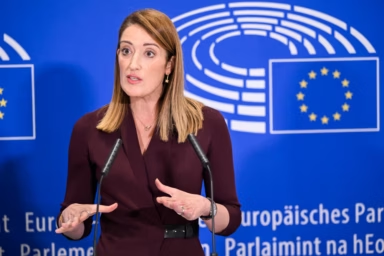European legislation is so complex that even lawmakers themselves often find it difficult to navigate. This often results in obsolete impact assessments or contradictions among various pieces of EU legislation. The European Economic and Social Committee recommends to streamline the voluminous process though the use of both plain language and digital technologies.
In order to avoid legislative confusion, Alena Mastantuono, Vice-President of the European Economic and Social Committee’s (EESC) Section for Transport, Energy, Infrastructure and the Information Society, advocates for clear “tables of obligations” to accompany new legislation. Digital tools, including artificial intelligence, should play a role in the process as well. The aim is to avoid duplication, reduce the administrative burden, and make the law clearer for businesses and citizens.
As rapporteur, you have prepared a recommendation by the European Economic and Social Committee calling for greater use of digital tools in lawmaking. What specifically are you proposing?
We prepared the opinion of the European Economic and Social Committee at the request of the Danish Presidency, which asked us how legislation could be simplified using digital tools and artificial intelligence. Based on this assignment, we analysed the use of digital technologies in regulatory activities in member states and then proposed a new model for European institutions. The primary goal is to set up filters that will prevent excessive regulation or administrative burdens. In addition, we wanted to ensure consistency and transparency throughout the legislative process, from the approval of the proposal by the Commission, through negotiations in the Council and Parliament, to final approval and transposition in the member states. An opportunity to set up this model is the emerging interinstitutional agreement on the quality of law-making between the Commission, the Council, and the Parliament.
You might be interested
Why is something like this even necessary?
The volume of legal acts is now so large that legislators are losing sight of the big picture of what they are adopting, as are the officials who take part in the preparation. Navigating this enormous volume of data is a superhuman task. Ultimately, it is the entrepreneur who discovers that there are overlaps in the rules, because the government wants them to report on the same obligations, but each time on the basis of different criteria, or that some rules even contradict each other, or that some laws are obsolete.
We want laws to be more consistent, not contradictory, and for harmony in the implementation of European law. Here we often talk about so-called gold plating. That is, when transposing directives, we ourselves add further administrative burdens at the domestic level.
We imagine it as a triangle: legal text, impact assessment, and table of obligations. And all of this should evolve during the legislative process. — Alena Mastantuono
We drew inspiration from a Czech provision that requires legislators to accompany adopted laws with a so-called table of obligations. This is essentially a summary of the law in question, written in very simple terms. It explains what obligations arise from it, who is to fulfil them and how, and what penalties follow for non-compliance. The introduction of the table of obligations at European level would not allow member states to deviate from the obligations defined in the table when implementing directives. It would also prevent the addition of new requirements.
Long way from theory into practice
At what level should the table originate? We are talking about European legislation, but for many regulations, the impact on businesses may vary from country to country.
The table should accompany legal acts at the European level. Today, as part of drafting European legislation, impact assessments usually accompany the acts. This assesses the benefits, but also the social costs of the legislation. And we want to add the table of obligations to this. Because whoever writes the text must know what it imposes. We imagine it as a triangle: legal text, impact assessment, and table of obligations. And all of this should evolve during the legislative process. So, for example, if the Council or the European Parliament amends the original Commission text, the table of obligations and the impact assessment should also align with it.
Is this not the case today?
Impact assessments should align with changes to the text, but in practice this rarely happens. Enrico Letta (former Prime Minister of Italy, who prepared a report on the state of the single European market at the request of the European Commission, presented last year) also drew attention to this need. He pointed out that this is indeed necessary. The impact assessment written for the Commission’s proposal often no longer corresponds to the actual content of the approved legislation.
Last year, the Court of Justice of the European Union pointed this out when it dealt with the mobility package. The provision required truck drivers to return to their vehicles’ country of registration for a period of eight weeks. It meant unnecessary detours. The Court ruled that neither the Parliament nor the Council had properly assessed its impact, and therefore repealed it.
Help from artificial intelligence
In your recommendation, you also mention the use of artificial intelligence. What form should this take?
When we extract obligations into a table using simplified language, we create structured data that artificial intelligence can then work with. The use of structured data and metadata is a helpful tool that can clarify European law and harmonize the 27 legal regimes in the member states. But it still needs qualified human oversight. We cannot do without that for the time being. As I mentioned, the volume is enormous. In its last term, 2019-2024, the Commission adopted over 13,000 legal acts. Artificial intelligence would help increase consistency for everyone involved in drafting new rules.
Artificial intelligence has a reputation for “hallucinating” sometimes. But people make mistakes, too. — Alena Mastantuono
Isn’t that risky? Artificial intelligence often makes mistakes.
We don’t want artificial intelligence to make decisions. Its role is not to determine what legal regulations should look like, but only to point out inconsistencies between individual legal acts. It is more of an assistant. Of course, artificial intelligence has a reputation for “hallucinating” sometimes. But people make mistakes, too. I think it can really be helpful here because it can navigate through the huge volume of data. Moreover, the European Commission already uses artificial intelligence, for example, to translate legal texts. So it’s not entirely new. At the same time, it is, of course, necessary to test and monitor artificial intelligence and set up feedback mechanisms.
Is there another way to use digital tools in the legislative process?
We want them to be used for implementation as well, to make life easier for entrepreneurs. We want to make maximum use of various pre-filled forms and calculators, similar to what we have today for filing tax returns online. Artificial intelligence can also draw on data from the economy. We have recommended that it should be possible to extract data from national databases so that companies do not have to report information that they have already reported to the state a second time.
One quarter less bureaucracy?
You mentioned that the report was initiated by the Danish Presidency. Have you received any feedback yet?
We adopted the opinion just before the start of summer. After the holidays, I will have the opportunity to present it to the public — both at an event organized by the Danish Presidency in Copenhagen and at bilateral meetings with Council representatives and MEPs.
The word “debureaucratization” has been appearing constantly during this term. What role does your proposal play in this effort?
The Commission has said that it wants to reduce the legislative burden by 25 percent during this five-year term, and by as much as 35 percent for small and medium-sized enterprises. This year, it began issuing various simplification packages, known as omnibus packages, by sector. Officials from various directorates-general are thus taking stock. They are looking at various areas where the legislative burden can be reduced. This is, of course, the right thing to do. We want to give them a tool that will make this easier for them and ensure that they all work in the same way.
Our recommendations draw on the experience and suggestions of member states, including the Chamber of Commerce’s initiative to reduce bureaucracy. They are primarily a practical solution to effectively streamline legislation, reduce unnecessary administration, and continuously monitor this burden with the help of modern digital tools.
—
Alena Mastantuono is the Vice-President of the European Economic and Social Committee. The EU affairs specialist with experience from both private and public sectors, particularly in the fields of the internal market, climate and energy, digital agenda and EU financing, has been a member of the committee since 2020.











